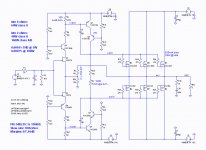There you go Jeff you figured it out 🙂 .........now replace the VAS mosfet's with high beta bi-ploar transistaors and run the sim and see what you get. Then you should be able to make a choice.
Jam
Jam
Attachments
Last edited:
Hi Nico Ras,
I will try these devices out if you are happy with them.
I prefer the Vbe multiplier
a) for safety reasons (if trim pot fails)
b) Sound wise I think they sounds better under high drive conditions (open to debate 😉 )
c) There are some interesting bias circuits that provide better tracking, something we should discuss later in the thread.
The amps I use are 600W monoblocks so this narrows my design choices.
I would like to know who the current distributor is. Their US office seems to have been closed.
Itsme,
I agree with you totally, this should be about learning and the exchange of ideas that everyone should be able to participate. Ego's should be left at the door. Whatever topology Jeff chooses would be a good starting point to push to the limit.
Jam
I will try these devices out if you are happy with them.
I prefer the Vbe multiplier
a) for safety reasons (if trim pot fails)
b) Sound wise I think they sounds better under high drive conditions (open to debate 😉 )
c) There are some interesting bias circuits that provide better tracking, something we should discuss later in the thread.
The amps I use are 600W monoblocks so this narrows my design choices.
I would like to know who the current distributor is. Their US office seems to have been closed.
Itsme,
I agree with you totally, this should be about learning and the exchange of ideas that everyone should be able to participate. Ego's should be left at the door. Whatever topology Jeff chooses would be a good starting point to push to the limit.
Jam
Last edited:
Thanks, Mark, but those are just SPICE stand-ins for 'E' grade KSC3503s (hFE 100 ~ 200).
I have no idea where either SPICE model sits, but the range for all grades of KSC3503 is 40 ~ 320 while the KSC2682 is 100 ~ 320, so it seemed a better fit to stand in for 'E' grade parts.
Hmmm..... I just checked Mouser and they're only showing 'D' grade KSC3503. I wonder where it was I got the 'E' grade last time....
I have no idea where either SPICE model sits, but the range for all grades of KSC3503 is 40 ~ 320 while the KSC2682 is 100 ~ 320, so it seemed a better fit to stand in for 'E' grade parts.
Hmmm..... I just checked Mouser and they're only showing 'D' grade KSC3503. I wonder where it was I got the 'E' grade last time....
Oh how annoying. Mouser has 'E' grade of the complement (KSA1381), but 'D' grade of the KSA3503. KSC3503E (and 2SC3503E) appear to be thin on the ground....
Don't worry it will still kick butt regardless of what grade you have.
Or are you disappointed you can't get matching grades.
If Sanken make to220 devices then check out them too.
I have some really nice toshiba to220 bipolars laying around, I might have enough to send you some. Won't know till I get home.
Or are you disappointed you can't get matching grades.
If Sanken make to220 devices then check out them too.
I have some really nice toshiba to220 bipolars laying around, I might have enough to send you some. Won't know till I get home.
Last edited:
...long trip pico?
How about a KSA1220 and its complement KSC2690?
Jam
How about a KSA1220 and its complement KSC2690?

Jam
Attachments
Last edited:
Jeff
I have no personal experience running bipolars using zero degeneration (it's usually reserved for mosfets), generally speaking the temperature coefficient of a bipolar wouldn't allow you to be able to do it. This will also cause problems for your output stage biasing circuit. It would be best to have the biasing circuit independent of the vas stage.
If you have the bipolars mounted on a huge heatsink it might work.
Jam might have a solution.
In a different topology using a ccs like those mentioned earlier, might be better. That's all assuming you are definitely going to be using a bipolar vas stage without degeneration.
I have no personal experience running bipolars using zero degeneration (it's usually reserved for mosfets), generally speaking the temperature coefficient of a bipolar wouldn't allow you to be able to do it. This will also cause problems for your output stage biasing circuit. It would be best to have the biasing circuit independent of the vas stage.
If you have the bipolars mounted on a huge heatsink it might work.
Jam might have a solution.
In a different topology using a ccs like those mentioned earlier, might be better. That's all assuming you are definitely going to be using a bipolar vas stage without degeneration.
Last edited:
...
How about a KSA1220 and its complement KSC2690?
Jam
They look good on paper, but the higher Cob nukes my phase margin.
I'm sure there's a compensation method to address that, but it would appear to be above my pay-grade. 😉
Jeff
I have no personal experience running bipolars using zero degeneration...
Ahh... no, that wasn't intentional. I just forgot to put it back when I switched from a MOSFET to a BJT.
How do I calculate how much degeneration I want?
Thanks,
Jeff.
One noticeable difference between the amp examples in Self's book, and the amp examples in Cordell's book, is the (lack of) emitter degeneration in the second stage called VAS. One book seldom/never uses it, the other book always uses it.
Is one of them "100% right" and the other "100% wrong" ? I doubt it.
Particularly when the stage is loaded by a current source, you can fairly accurately work out its gm using a calculator or pencil+paper, in both cases. And that's what you need for stability computations and for open loop gain.
Is one of them "100% right" and the other "100% wrong" ? I doubt it.
Particularly when the stage is loaded by a current source, you can fairly accurately work out its gm using a calculator or pencil+paper, in both cases. And that's what you need for stability computations and for open loop gain.
Last edited:
I noticed Papa generally goes with the inverse of the transconductance at the operating point on mosfets, maybe that rule is also a reasonable starting point for bipolars.
Eg If the transconductance was 0.5S at the operating point then a 2 ohm resistor, if it was 10S then a 0.1 Ohm resistor.
Try 50 Ohms and throw a trimpot in parrallel and see how low you can go before the bipolar starts thermally taking off, once you know where that is replace with fixed resistor.
If you go with a single ended VAS with ccs, you can probably go the fearless route.
Eg If the transconductance was 0.5S at the operating point then a 2 ohm resistor, if it was 10S then a 0.1 Ohm resistor.
Try 50 Ohms and throw a trimpot in parrallel and see how low you can go before the bipolar starts thermally taking off, once you know where that is replace with fixed resistor.
If you go with a single ended VAS with ccs, you can probably go the fearless route.
Last edited:
Cordell uses Re = N / gm where the number N is usually much greater than one. But is this choice "100% right" ? I doubt it.
pico has it .......de-generation is key..............especially with bipolars and their higher trans-conductance.
It think the basic topology is sound, the magic is in the details and optimizing the circuit. this separates a good amplifier from a great amplifier.
Some suggested ares to look at
1) De-generation and where to use it.
2) Optimizing the cascode circuit
3) Choice of bias circuit
4) Choice of output stage
5) Power supply
6) Protection circuit (if required)
Jam
It think the basic topology is sound, the magic is in the details and optimizing the circuit. this separates a good amplifier from a great amplifier.
Some suggested ares to look at
1) De-generation and where to use it.
2) Optimizing the cascode circuit
3) Choice of bias circuit
4) Choice of output stage
5) Power supply
6) Protection circuit (if required)
Jam
Last edited:
Now let me throw something at you......good read!
Jam
Jam
Attachments
Last edited:
Cordell uses Re = N / gm where the number N is usually much greater than one. But is this choice "100% right" ? I doubt it.
I brushed up on Cordell again and his rule of thumb is to have the total effective emitter resistance be about 10 times the intrinsic emitter resistance at the operating current.
So re' is 0.026/Ic. My sim currently has the VAS running at about 25mA. (I assume this is reasonable?)
That gives me an re' of ~ 1, an (Re + re') target of 10, and an Re target of 9, give or take.
...It think the basic topology is sound, the magic is in the details and optimizing the circuit. this separates a good amplifier from a great amplifier..
Ha! Since this is my first excursion off-piste, I'll be happy enough if it makes music at all. 😀
- Home
- Amplifiers
- Pass Labs
- JamJar: an HPA-1-inspired power amp


